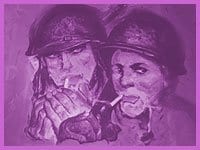This year the Images Festival has undergone a makeover at the hands of new artistic director Jeremy Rigsby. The “off-screen” media art installations receive greater attention and the “on-screen” international shorts program are tighter, more thematically imaginative and consistent than they’ve been in the past.
Two of the queerest programs are near the end of the festival: Fancy, Furry And Sticky (7pm on Fri, Apr 15), devoted to the messiness of television and childhood, and American Afterworld (7pm on Apr 16), about the past, present and future of US manifest destiny.
The first begins with a short black and white collage piece called Me, Myself And I by Kelly Spivey that cuts up a particularly gender-essentialist song by Mr Rogers, the saucily titled “Everybody’s Fancy,” that includes the lyrics: “Boys are boys from the beginning/ Girls are girls right from the start/ Girls grow up to be the mommies/ Boys grow up to be the daddies.” The visuals consist of an array of animated retro paper dolls putting themselves together and taking themselves apart, composing and decomposing their bodies and outfits with reckless abandon against a field of fragmented film strips. The cut and paste of collage animation makes mincemeat out of poor old Mr Rogers’ biological determinism.
This piece is followed by the latest masterwork by Martha Colburn, Cosmetic Emergency, which she worked on as an artist in residence at the Liaison Of Independent Filmmakers Of Toronto. Colburn is the queen of jarring and monstrous mixes of cut-out and painted animation. And here she satirizes the US military’s generous policy of providing cosmetic surgery to its soldiers and their dependents. This piece takes her work to a whole new level of complexity, incorporating a richly grotesque sound collage and found footage (including the “Ambassadress Of Cosmetic Surgery For The Netherlands”) with her own images of pretty ladies and soldiers which she transforms through animation into ghouls equal parts decayed and beautified. She also takes classical paintings by the masters and perverts them with her mutating painting style.
Colburn’s piece segues nicely into Jeremy Drummond’s disturbing but occasionally obvious deconstruction of American homeland security paranoia Home Is Where You’re Happy, the name of a song by that wacky old coot Charles Manson. It begins with a “dramatization” of an inept attempt by a child predator: A comically shady-looking man in a Hawaiian shirt scatters candy around a playground as bait. When Britney Spears appears singing “Boys” as e-mail spam messages for porno, medications, get-rich-quick schemes and weight-loss scams roll over her you think you’re in for a treatise on “the paedophilia of everyday life” and such. But the piece quickly turns into an unsettling examination of a more generalized American lust for violence: pro wrestlers getting whupped, Cannibal Corpse lyrics, a kid being arrested at a fairground. A scene of a damaged aggressor/gore movie enthusiast jerking off to surveillance footage while using blood as a lube lays it on a bit thick (and pales in gracefulness compared to Steve Reinke’s serial killer-themed videos). The climax of this fascinating if flawed tape is Drummond’s footage of a Manhattan store called Safer America (Saferamerica.com) with a gas mask in the window that looks eerily similar to the face of an inflatable sex doll. As the prices of family-size apocalypse protection kits flash by on screen, Drummond nicely sums up the out-of-control commingling of eros and thanatos in 2004 America, where the iconography of fucking and killing have become increasingly indistinguishable (thank you Max Hardcore and Abu Ghraib). Drummond is also smart enough to acknowledge that this phenomenon is nothing new by including footage of a pre-videogame toy where the goal was to bomb Japan, and an excerpt of a woefully naïve nuclear bomb self-defence films.
Drummond’s apocalyptic channel-surfing would be equally at home in the American Afterworld program. Beginning with Gary Kibbins’s disastrously self-righteous rant April 1967, the rest of the films are thankfully much stronger. While the notes claim that Vanessa Renwick’s Britton, South Dakota is “an elegiac hymn… reminding us how poverty represents the implosion of a country’s greed,” you don’t really see any evidence of that in the work itself. Renwick takes footage of young kids shot in the late 1930s by a Britton resident (and projectionist) named Ivan Besse and adds mournful organ music. The footage – especially the children refusing to be documented by walking away or crying hysterically – and the atmospheric soundscape are achingly beautiful. But the piece seems to say much more about the passing of time and the essentially morbid tone of documentation – many of these Depression-era children are likely dead – than about the ravages of capitalism.
This piece is followed by Soothsayer by Bobby Abate, a clever skewering of those who claim to be able to tell us meaningful information about the future. Abate draws parallels between our unwavering desires for prophecies and the utopian promise of technology. The Kennedy assassination as well as the sadly unsuccessful attempt on Reagan’s life make appearances here, as do a number of apocalyptic situations dreamed up by psychic authorities intent on awing us. Here their predictions seem woefully inept, brought to life through lacklustre computer graphics and once-promising images of store-bought pleasure.
Next up is Steve Reinke’s Anthology Of American Folk Song, which I reviewed enthusiastically in an earlier issue of Xtra. Definitely check it out if you’ve missed it – a subtler, more thoughtful and, in the end, more distressing counterpoint to Drummond’s vision of a permanently broken America. The program wraps up with things we want to see, a lyrical, evocative travelogue of sorts by Rebecca Meyers. The soundtrack is composed of excerpts of a family’s 1955/’56 New Year’s Eve celebration. The images are primarily of the natural world: ice flows, butterflies, the glint of sunlight on the ocean, whales and a dog whose behaviour resonates as a sign of the times more loudly than any CNN broadcast or doomsday art video. It is six minutes of pure bliss.
Some other highlights include the quietly sublime Water, Water by Nicky Hamlyn, which brings hyperactive strobe effects to bear on a meditative exploration of the subtle details of light playing on reflective surfaces. Michael Stecky’s surreal Harmaline is a strange but satisfying mix of abstract and representational forms that evokes an ecosystem of saturated colour both imaginary and material: a flowing dreamscape of sea horses, forests and skulls set to an equally idiosyncratic soundtrack. Nova, a 35mm film by Peter Collis that manipulates footage of bonfires, fireworks and dancing emulsion scratches rounds out the program dubbed Burst (9:15pm on Tue, Apr 12).
Finally, the film Remains: A Preliminary Investigation by Laura Daroca is a highlight of the program dedicated to personal and political history and memory, Things Gone And Things Still Here (7pm on Apr 13). A silent video, it calmly and meticulously describes what happened when the filmmaker found 70 photos, 23 negatives, a newspaper and 11 miscellaneous objects belonging to a woman named Kathryn Elwood in Santa Monica. Daroca visits every place mentioned in the mementos, most of which simply do not exist anymore. She investigates the travels, celebrations and friendships of Mrs Elwood, who died almost 50 years before these objects were found in a trash can. Daroca methodically shows us each piece of evidence, making no extravagant claims but simply stating the facts. Despite its even-keeled tone, it reveals volumes about why we obsess over the old, antiquated and discarded.
IMAGES FESTIVAL.
$8 per screening; $75 pass.
Thu, Apr 7-16.
Innis Town Hall.
2 Sussex Ave.
416-967-1528.
Imagesfestival.com.


 Why you can trust Xtra
Why you can trust Xtra


